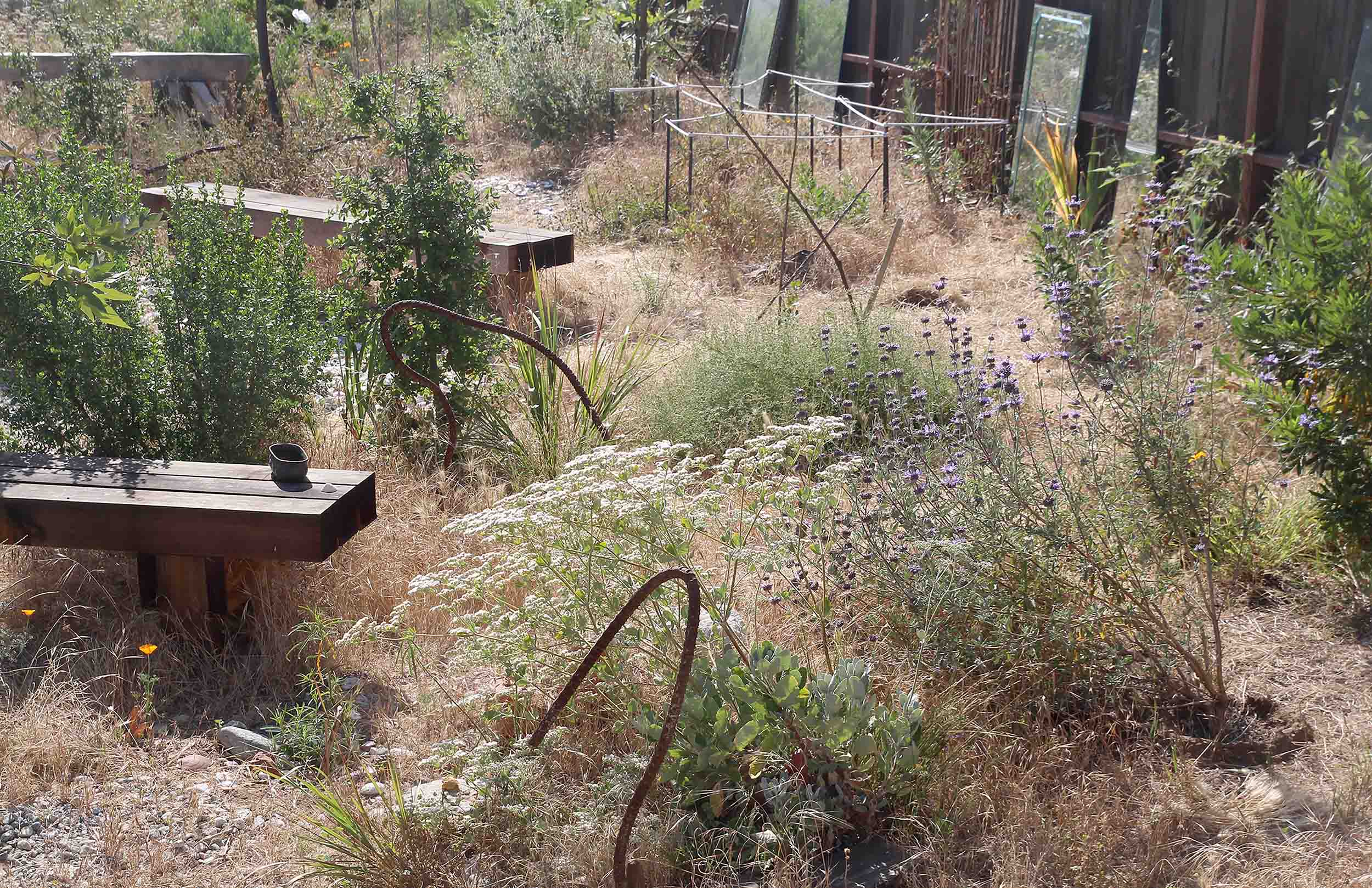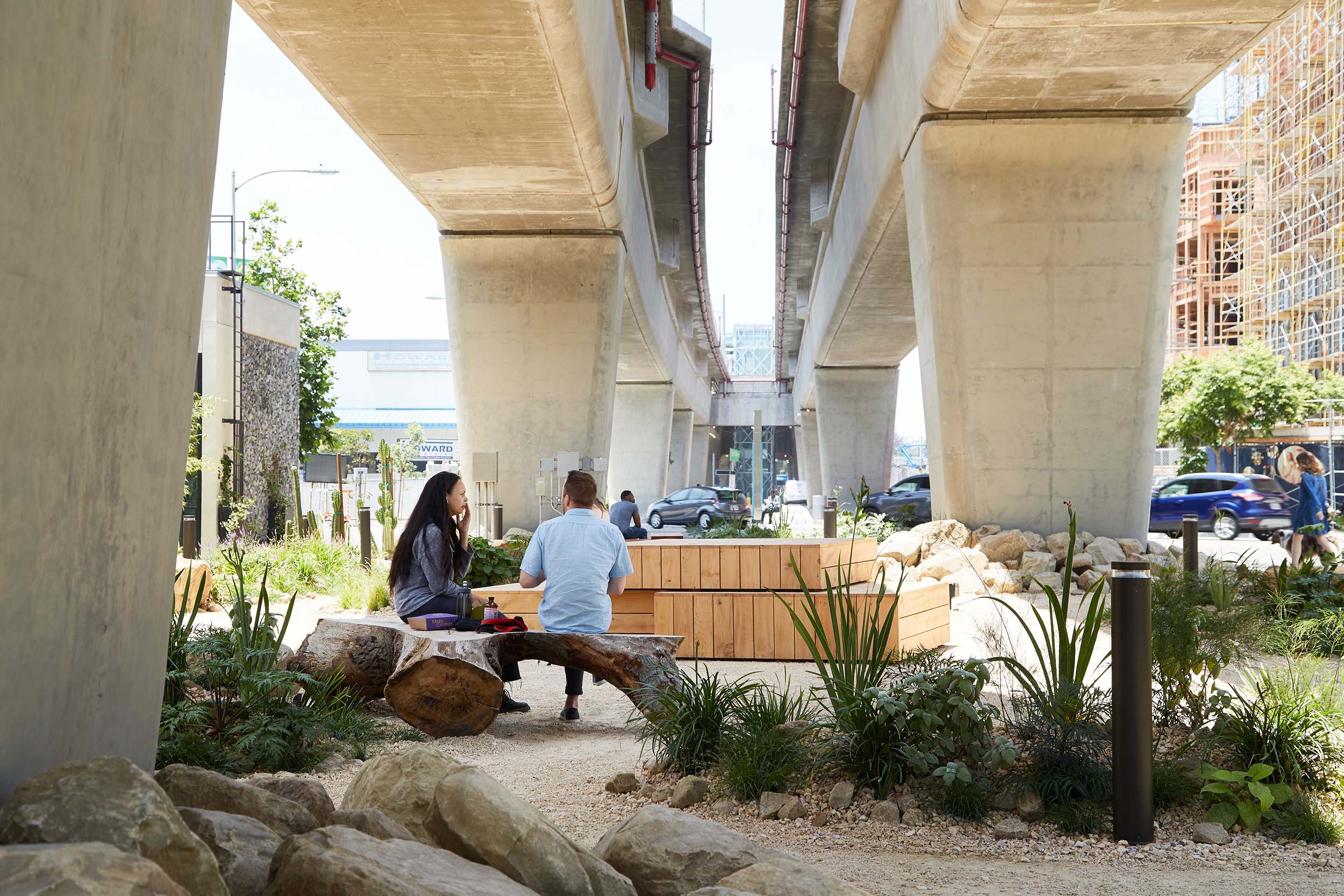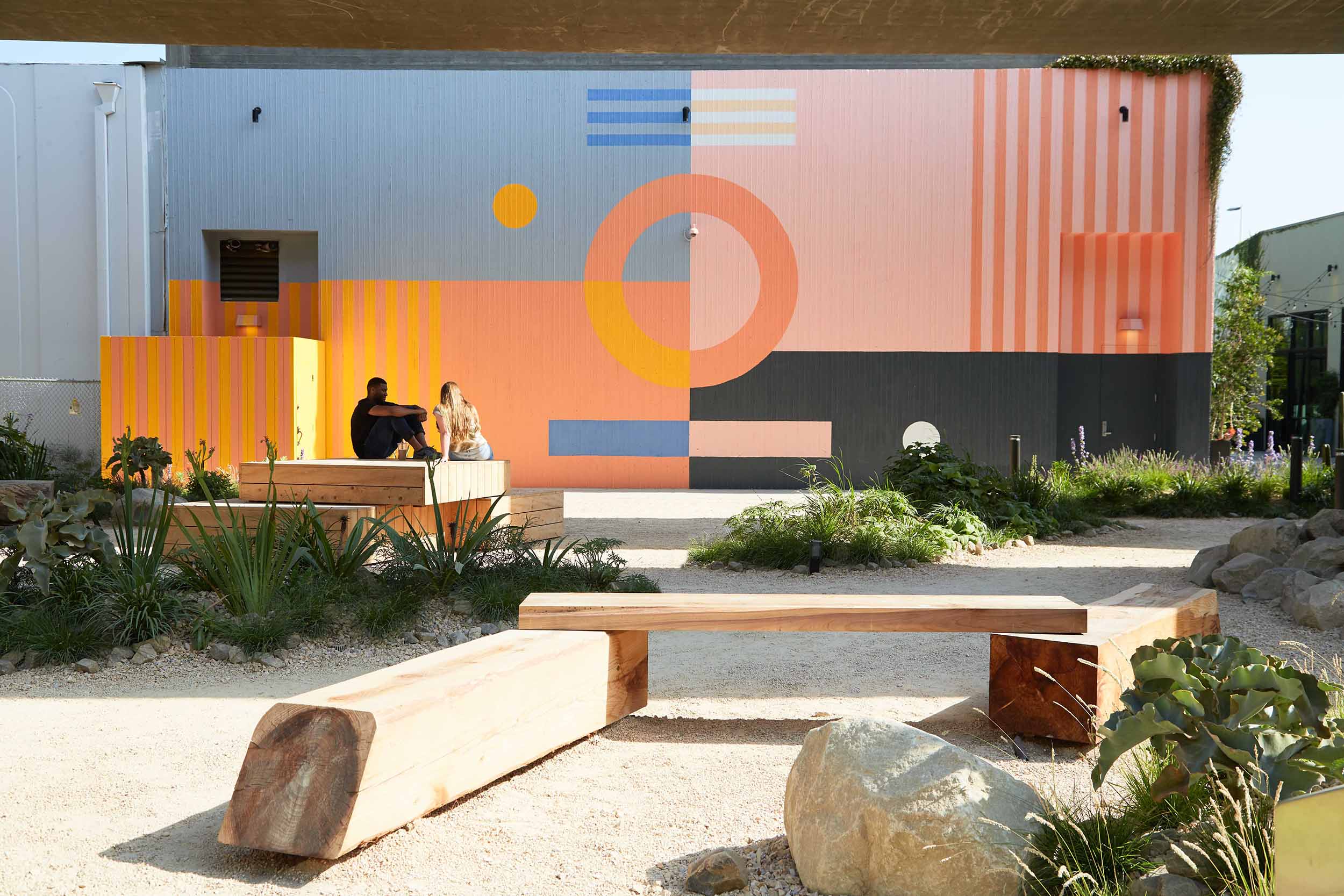Landscape Architecture as Crystallization of a Region
David Godshall and Story Wiggins discuss TERREMOTO's focus on vernacular materials and native plants.
TERREMOTO is a 2023 Emerging Voice.
What does it mean for a landscape architecture project to be of its place? For California-based practice TERREMOTO, the answer increasingly involves the use of hyperlocal materials, from seedlings to gravel and furniture. The firm argues that this approach can strengthen local communities and improve environmental outcomes while creating new aesthetic opportunities.
The League’s Rafi Lehmann met with two of TERREMOTO’s partners, David Godshall and Story Wiggins, to learn more.
*
Rafi Lehmann: Tell us about TERREMOTO’s use of locally sourced materials and plants. How and when did this approach start?
David Godshall: Our focus on hyperlocal materials started most meaningfully on our Platform Park project. We had used local materials before this, but on that project, we overtly challenged ourselves by asking the question, “What if we built a park whose materials all came from within 100 miles of the project site? What would be the aesthetic ramifications of such a decision?”
We learned that yes, it’s possible, and that such an inquiry comes with visual implications—but maybe we need to start welcoming those constraints into our projects if we want our work to embody a new regional vernacular that is also carbon-light.
So the gravel and decomposed granite for Platform Park came from 98 miles from the project site. The wood on the project was sourced from Angel City Lumber, which is a local materials yard in Los Angeles. Angel City Lumber basically intercepts trees that are coming down in the city that would be going into wood chippers and then puts that material to good use by milling it. So the wood we used on the project came from the city of Los Angeles itself. The plants were grown in a nursery within 100 miles of the job site.
Lehmann: Why this approach?
Godshall: We’re interested in landscapes speaking the vernacular language of where they find themselves in the world. Our present moment is so inescapably globally connected that materials have almost lost their geographical provenance, and this is deeply problematic on a variety of levels. I feel like landscape architecture has drifted away from the beauty and strength of regionalism, and from thinking about designed landscapes as curated crystallizations of region and land.
And COVID really exposed the fragility of our dependence on a global material supply chain. A jolt to the system like COVID and suddenly lead times are horrendous and the materials are stuck on ships in God-knows-where. So that was a good moment to ask ourselves, “Why are we building gardens that bring stuff from overseas when you can make a garden that’s composed of materials from the place in which it sits in the world, and that’s also beautiful?”
So we were interested in both the aesthetic implications of what that might mean, as well as knowing that the more geographically close the materials are, the more carbon-light a project is going to be. And now, anytime we have the opportunity, we’re thinking more and more deeply on the materials that we use in our projects.
We’re also increasingly trying to build projects that have a majority of native plants in their gardens. We do so because it checks a lot of boxes and is sensible in a lot of wonderful ways. Native plants need fewer external inputs in terms of water and fertilizer, and, because they evolved to exist in the place where they exist, they also provide habitat for other creatures. They consume less and give more. Constructing gardens that require less energy in their creation as well throughout their ongoing existence seems appropriate and necessary in this moment of environmental uncertainty.
Building gardens that are as useful to the wildlife of their place as they are to humans is something else we’re increasingly focused on. Even a deeply loved garden is probably uninhabited 90 percent of its lifecycle. So in the moments when it’s not being used by humans, the usefulness of the garden to other creatures seems like a cool thing to consider.
Story Wiggins: A secondary lovely thing that has come out of this hyperlocal approach is the relationships that develop through sourcing local materials. That was something unexpected and important that came out of the process.
More and more, our design approach comes out of these relationships. It’s not like you start a project, design it, and then you’re like, “Oh, I have to find all these materials locally.” It’s more, “Oh, we know this guy who mills beautiful timber benches,” so that’s in our toolkit to use on projects.
Also, materials that are locally sourced can have more meaning through their connection to a web of community. They start to have several layers of meaning. On an aesthetic level, they’re beautiful; on an ethical level, they’re more sustainable; and on a social level, they remind you of a relationship you built or an amazing craftsperson you came into contact with through the project. You’re not just extracting resources from a place you’ll likely never see and people you’ll never meet.
Godshall: We have an ever-expanding repertoire of these local resources. And in a quiet way, we are creating economic resilience within our own communities by shopping with people who live down the street.

A local community of designers, craftspeople, artists, and materials suppliers formed around TERREMOTO’s Cafe Ohlone project, an Indigenous-owned and -operated cafe outside UC Berkeley’s Hearst Museum of Anthropology. From dishware to plantings, the cafe’s material choices reflect both Ohlone traditions and the owners’ relationships with the community members who contributed to the project. Images credit: Caitlin Atkinson
Lehmann: You mentioned the aesthetic implications of using hyperlocal materials. Could you tell us more about those implications?
Godshall: It’s a funny thing. If you approach a landscape design without this desire to use hyperlocal materials, you might go to the landscape materials yard and say, “Well, do we want the gravel to be gray or tan?” And it becomes an aesthetic decision.
That’s not bad; aesthetics are still important and things should still be beautiful. But if you come at it with, “Well, what’s the local material?” your choices are oftentimes more limited. And generally, that has proven to be a good thing: embracing the idea that gardens should be expressions of their region.
Wiggins: I think the beauty of it is that this usually leads to an aesthetic that feels like it fits in that place. It makes sense there.
So much of the vernacular of Los Angeles and San Francisco is a hodgepodge of things from around the world. So we’re kind of reeling that back in and saying, “Okay, what actually fits here?” rather than having this vast library of materials and styles to go to.
Sometimes you could get caught up in, “Oh, limiting your materials is such a bummer because you can’t just have fun with it.” But as we all know, having constraints can be a real boon to the design process, and that definitely is the case with materials.
Godshall: I think that also speaks to our ever-increasing interest in design solutions as being emergent of the place in which they exist rather than impositions.

TERREMOTO’s 7th Avenue Garden project (a collaboration with Los Angeles-based artist David Horvitz) uses local materials largely removed from typical landscape material supply chains: oyster shells gathered from restaurants, plants from seed, wood from Angel City Lumber. Godshall has called it a “feral space mostly composed of the detritus of Los Angeles.” Image credit: TERREMOTO
Lehmann: I would love to hear you elaborate on the challenges of this approach. Have you received pushback from the people you work with?
Wiggins: I think there are limits with high-end residential just in terms of expectations. We definitely come up against that. But with any project, if we can get some amount of this energy in, we’re happy. It doesn’t have to be, like, “We’re changing everything about how projects happen overnight.”
Godshall: Yeah. Let’s be mean to tropical hardwoods for a minute—and the love that people have for, like, ipe and teak.
Wiggins: Yes, please.
Godshall: Don’t get me wrong: Early days, we built some decks with ipe and teak. But now we no longer use tropical hardwoods.
I’m not going to lie: They perform incredibly well and they’re objectively beautiful. The way they silver out, and their longevity, is really quite incredible.
So clients might ask, “Well, then what can I use that’s as durable?” In the United States, I’d say products like Thermory or Robi Decking, which mills junk wood and then thermally modifies it so that it behaves essentially like a tropical hardwood.
But I would ask the client, “Well, why the obsession with your deck needing to last 25 years? Because I would offer that your desire for your deck to look a certain way and last 25 years is probably less important than trying to preserve the rainforest, for example.”
Wiggins: But there are limits to this approach. There are certain things that you just can’t really source locally, like steel.
Godshall: Totally. Like, the use of concrete is inescapable, and concrete’s objectively not good for the environment. But if we need to make a path ADA accessible, then, in all likelihood, it’s either stabilized decomposed granite or it’s concrete. So when we have to break our own rules, we just try to do the bad thing surgically and sparingly, and deeply limit the harm.
This is all aspirational and evolving, and we’re not perfect by any means. We’d be lying to you if we said every material on all our projects comes from a 100-mile radius of the project site. It’s just something we’re increasingly conscious of.
We are still installing irrigation systems on projects, and that’s plastic that comes from God-knows-where. But at least we’re aware of that now, and that’s starting to inform how we approach planting.
In our offices, we’ve been tinkering with trying to build gardens that don’t need irrigation systems. Can we design a garden whose planting plan is so damn good that once it’s established it no longer needs supplemental irrigation? We think the answer is yes.
But this would potentially involve supplemental hand watering, which complicates things. The fact is that the garden maintenance industry is undervalued, so gardeners can’t typically devote much time to an individual house because they need to service X number of houses each day to earn a living.
So we’ve been thinking, what if we take the $10,000 that a client would be spending on an irrigation system and say, “How about you spend four grand on a gardener to do this work instead?” We’re starting to explore perhaps having an in-house gardener in our office, and this system could potentially allow us to pay that person a living wage.
So these opportunities can start to build on one another.
Lehmann: Where does the wider construction industry stand on native or vernacular materials? Do you see major developers and the like being influenced by this sort of work?
Godshall: The mainstream construction materials and building industry in California is mostly completely unaware of this issue. We are kind of the weird outliers, hoping that this approach becomes more mainstream.
But even if the industry did get interested in local materials, there are other barriers that are holding this kind of work back. To complain about the building department for a moment, we’ve bumped into problems with things like materials testing.
To give you an example, a friend of mine was building a deck at his house in Pasadena, and he asked what materials he should use. I said, “Don’t use tropical hardwoods; don’t use Trex, the plastic wood.” And I gave him some alternatives, like redwood.
And then I came to his house as he finished up construction, and his deck was ipe. I was openly sad and was like, “What happened, dude?” And he said that because he lives in a high-fire zone he can’t get a building permit to use redwood, for instance, because of the fire-testing requirements materials have to meet in these areas. He actually can’t use local wood from Angel City Lumber because they’re too niche of an industry player to spend the millions of dollars it would take to meet these material qualifications.
Those fire regulations make sense: The intention is to preserve human life. But if you zoom out to a global scale and think about climate change, I would offer that we should be making exemptions for hyperlocal materials in certain capacities.
So I think some of these building industry metrics are flawed. I don’t know how we solve that, but I think it’s important that, as designers, we start raising our hands and saying it’s a problem that we can’t get a permit using local materials.
Wiggins: Although to go back to the idea of approaching projects in a different way and thereby subverting the norms of the construction industry . . . We’re talking about how redwood is better than tropical hardwoods, but at the end of the day all construction is just wildly destructive. It just is: You know, big machinery is coming onto the site and compacting the soil. You’re scraping the site; you have to cut down trees. One of the weirdest things when I started this job was, like, “Oh, I didn’t realize that as a landscape architect, a big part of my job was going to be telling people which trees to cut down for fire safety or viewshed or siting a building.”
So one thing that we’re also interested in is approaching projects in a more long-term way, right? Moving away from the current model of construction—“We’re going to create a construction set and show up on the site, and within four months the project is going to go from demolition to completion”—toward instead working with existing conditions, working with a gardener, allowing the materials from the site to be harvested and, over the course of years, become something else on the site. I mean, if a tree comes down, you could chop it up and cure it and turn it into something.
This won’t be how we operate on most projects for a long time, but we’re very much interested in transitioning to designing iteratively and emergently over the long term whenever possible.
Lehmann: Have you taken a hyperlocal approach on projects outside of your home base?
Godshall: This gets into very interesting territory. We are actively working on projects that are outside of our home base, while also being very skeptical of working on projects that are outside of our home base.
In the landscapes we’re familiar with, we can read the landscape with some clarity and intellect. I think Story could walk into a landscape in the Bay Area and tell you if it’s an ecosystem that’s intact or that’s wildly out of balance, and I can do the same in Southern California.
But the traditional trajectory in design offices is that with success, people start to ask you to work on projects that are far away. We believe that it’s easier to do harm in places with which you are unfamiliar. The starchitect model of, “Oh, you figured out how to do things in one place. You should go and do that everywhere” is something that we take issue with. And so when we get asked to work on projects that are far away, we kind of double down on the principles that we’re going over with you.
For a project that [TERREMOTO designer] Kasey Toomey recently led in Denver, we simply did our best to use hyperlocal materials. For the planting plan, we engaged with a local horticultural consultant who knows the plants better than we do. That’s how we balanced it.
So we’re just going slowly and trying to do our best. And when we work in a place that we’re not familiar with, we go back to these very basic principles as a way of insulating ourselves from building landscapes that are out of context for their region.
Lehmann: Do you think of yourselves as creating a new vernacular using these constraints? Or do you think you’re continuing a kind of historic vernacular?
Wiggins: That’s a great question. I kind of love the term “new vernacular,” and I think there’s some truth to that. But it also kind of belies the fact that, like, everything’s been done forever. I don’t think we’re necessarily inventing something.
Godshall: Yes. And I’d also add that architecture and landscape architecture are inescapably symbolic of the moments of history in which they are created. I think we live at a moment where we’re starting to question our reliance on things that come from far away.
Wiggins: One of our biggest hopes for this work is that people will start to see the beauty and functionality of creating landscapes in this way, and that it will become vernacular in the sense of, that’s just what you do: that’s the easy, functionalist thing.
Interview edited and condensed.
Explore
Walter Hood: Conscious/unconscious landscapes
Oakland-based designer Walter Hood discusses his community-centered practice.
Future Green Studio lecture
David Seiter, founder of Brooklyn landscape design firm Future Green Studio, presents his work.
Mia Lehrer lecture
Mia Lehrer is known for her commitment to environmental and community advocacy in Los Angeles and beyond.




